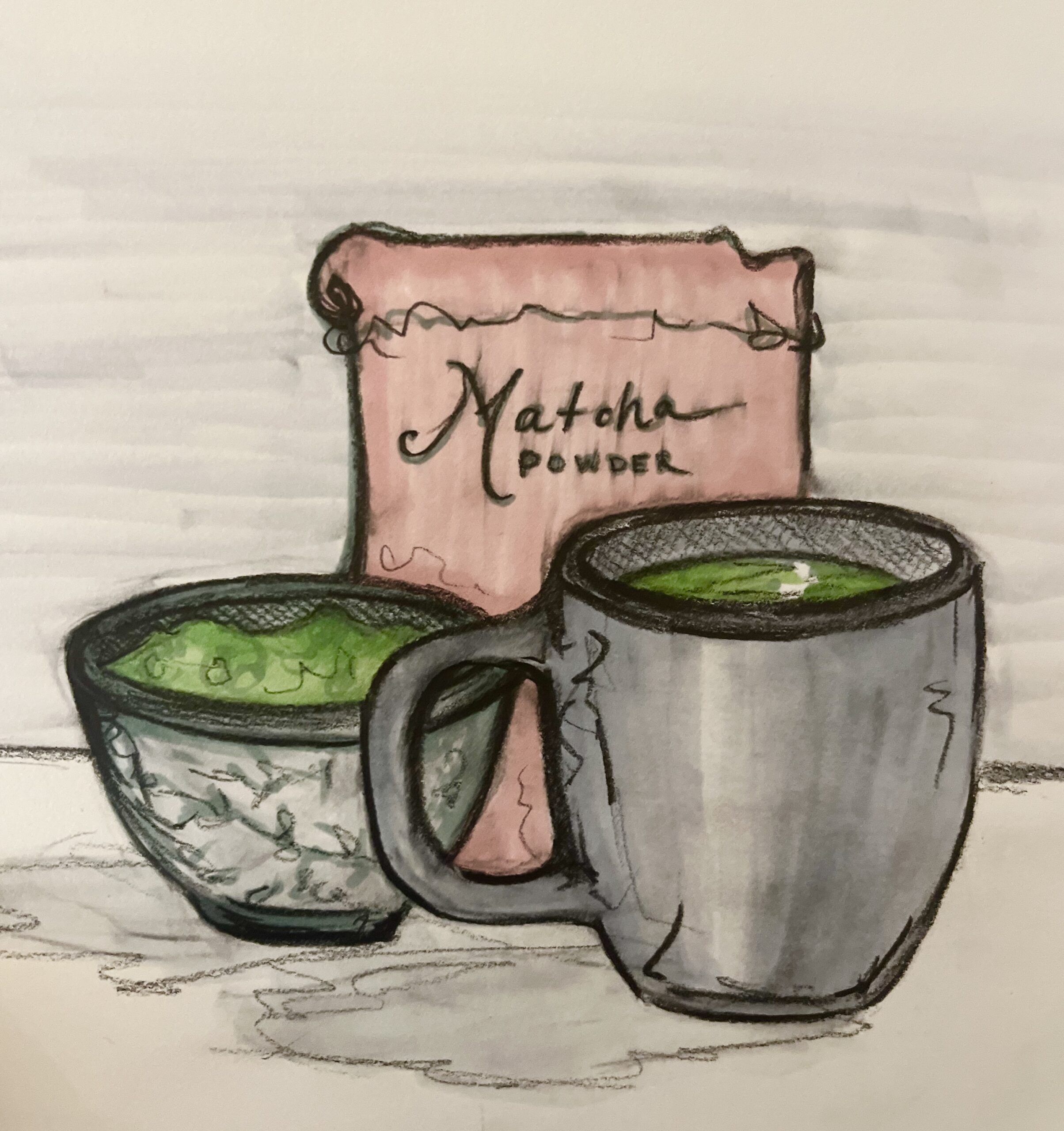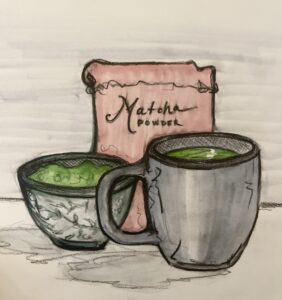

Art by Anna Chamberlin
If my dorm room is my holy sanctuary, then my matcha cart is my fountain of life. Over this semester, empty matcha tins on the cart have multiplied.
In a way, matcha feels like a long-lost love that I’ve unknowingly ignored. My earliest memories came from my dad, who frequently ordered matcha lattes at coffee shops for my sister and me. My dad was an avid believer in the daily cup of joe. My mom never drank caffeine under any circumstance; she treated it like a forbidden fruit. And she insisted that coffee would stunt our growth, so this grassy concoction was the happy medium between them.
Unfortunately, I grew akin to my dad, and matcha soon faded into the background. For most school days during my senior year of high school — when I was old enough to defy my mom’s anti-caffeine wishes without many consequences — I’d fill my 30oz YETI tumbler with diluted black coffee. Lukewarm, unsweetened, no milk, made by a Keurig. It was tragic. But I drank it out of necessity: it was hard to keep my heavy eyes open. My days went school, then crew, then gymnastics, then homework. My days felt boundless and my nights were bounded by a maximum of six hours of sleep.
But after my college acceptances came flooding, I suddenly found myself craving something greater than Keurig coffee, which by this point was laced with high school anxieties, fears, and dreams. I had outgrown it, I thought.
Moving on seemed easy. Matcha entered my life along with a sense of success and a newfound sense of self. Brewing that first cup in a quiet kitchen, right after committing to college, felt like an unexpectedly large ritual. I took a sip, steadying myself, and thought about how grown up I felt. The irony was stark: my inability to drink coffee as a child made me revere it as a grown-up drink, but now I associate it with adolescent oblivion. I was disillusioned by prohibition, craving something I never wanted in the first place.
Still, I had a bit of a relapse: my first year at Yale became an ode to the espresso bean. Atticus and Willoughbys made frequent appearances on my credit card statements. It wasn’t just the ritual that gripped me; it was the bite of the caffeine, that sharp jolt of purpose. Albeit this purpose wasn’t a real call to action, but a call to work, mindlessly churning out deliverables for my professors and my delusioned self.
Old habits die hard, but they can still die.
Then, the summer before sophomore fall, my family visited Osaka and Kyoto. Away from a life gorged with school assignments, and my need for coffee diminished. And, after Japan, I reconsidered matcha — perhaps because of my nostalgia for my serotinal train ride to Uji or for quality time with my family. It could also be as simple as the fact that matcha—with its L-theanine and antioxidants, which are incomparable to coffee and its jitters— makes me feel good. Good, like getting-into-Yale good. Or traveling-with-family good.
I wanted matcha-feelings to never stop, so I put a matcha cart in my sophomore-year dorm to keep a constant stream of goodness; since then, I’ve made matcha everyday.
Each time I whisk the matcha, purpose settles over me like an inevitable grace. This purpose feels different, almost raw. I’m whisking matcha because I want to. I’m flowing with a liquid consciousness, where I’m aware of every action and desire that billows throughout my body, dorm room, world. With each flick of the wrist, I feel as though I’m standing in the middle of the Jordan, not to be washed away, but to be reborn. Outside my window, York Street hums with the usual chaos, but here, with my cup in hand, I’m momentarily removed. I’m wandering through my own desert, where time slows and the world moves on without me, just a little longer. I’m sure getting into Yale or traveling to Uji didn’t directly give me this life-altering purpose, but it did clear the fog. Eyes-wide-open, I’m seeing, not for the first time, but in a sharper light, piercing through naivety like bullets.







